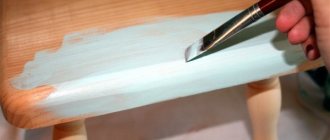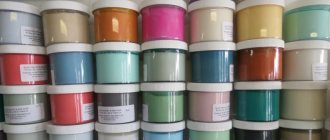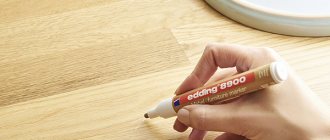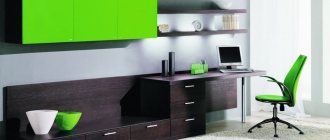Pros and cons of using
Unlike other products, the mixture does not lie on the surface of the wood, but penetrates its internal structure. The texture of the wood does not deteriorate, and the heat is retained for a long time. In addition, wax has the following advantages:
- The surface acquires a natural velvety feel to the touch; there is no glossy polishing.
- Furniture made from natural wood will sparkle with new and expressive colors.
- The range is presented in various tinting options: any furniture will harmoniously fit into the interior.
- In terms of its external composition, wax is a thick, dense mass that completely fills chips, cracks, scratches and other mechanical flaws.
There are many more pros than cons. The main disadvantages include the low protective level compared to the same varnish. It is also impossible to completely disguise marks and stains that form as a result of the harmful effects of moisture and sunlight.
What is
Oil-wax for wooden furniture is a material used for polishing interior items.
As a result of its use, a protective coating with good performance characteristics appears on the surface.
The main components of the material, as the name implies, are oil and wax. The first agent penetrates even into the lower layers of wood, protecting it from external negative influences, preventing the destruction of the solid structure. Wax forms a hard coating on the surface. It also protects the wood from external negative influences, and also increases the attractiveness of the furniture.
Types of material
There are many types of wax-based materials. The modern market offers the buyer the following varieties:
- Soft. Experts recommend using it to restore furniture and remove chips, dents and cracks. The restored surface can easily withstand physical stress. In addition to wood, the soft type is ideal for laminated flooring. No preparatory work is required; the mixture is sold ready-made. Using a plastic spatula, a certain amount of mass is applied to the dent or crack. If you need to create a specific color, several shades can be mixed with each other. Excess mass is removed with a spatula.
- Solid. The material has a dense structure. The solid consistency is ideal for both internal and external restorations. Easily copes with your favorite surface imperfections. Use a soldering iron to melt the wax. After this, it is applied to the damaged wooden structure. Within a matter of seconds, the mixture is completely absorbed into the layer. Excess is removed with a spatula.
- Liquid. It is customary to add synthetic components to its composition. Thanks to this, the consistency becomes liquid. This mass is easily applied to the surface using a brush or soft brush. It completely penetrates scratches and cracks, and is presented in stores as a creamy structure. It will take a minimum amount of time for the liquid to dry completely.
All varieties contain the following natural ingredients:
- Essential oils of coniferous plants;
- Tree resin;
- Drying oil;
- Beeswax;
- Olive, linseed oil.
In everyday life it is convenient to use a wax pencil for furniture - from scratches. It is available in a wide range of colors and has water-repellent properties. After its impact, the furniture looks like new. Used on varnished and laminated surfaces. Using furniture wax is very simple and convenient.
Features of varieties
Furniture wax of soft and hard grades has its own characteristics.
Soft
Use it to get rid of scratches, chips, cracks and dents. Even if there are large broken edges or holes from self-tapping screws, this remedy will be effective.
In order to apply it yourself, you must follow these recommendations:
- To restore objects, the product must be rubbed in thoroughly.
- Use an edge knife to apply wax to the edges. The missing piece of furniture should also be formed from it. You need to level the surface using a spatula.
- Excess pieces of material are cut off with a knife. Smooth the plastic surface with a corner.
- You can use a felt cloth to polish the repaired surface.
Using such a pencil, you can restore patterns on furniture.
Solid
Such wax pencils have the same purpose as soft ones.
They differ in that:
- have a high degree of protection against mechanical damage,
- can be used for DIY restoration, but only after melting,
- their price is higher than soft ones,
- they are not easy to find,
- There are few color varieties.
The features of removing scratches with your own hands using this product are the same as in the case of soft ones. But a hard pencil must first be melted using a lighter, blowtorch or torch.
Rules of application
Short rules will help an amateur use furniture wax correctly and complete restoration work without errors:
- Surface preparation. For uniform impregnation, the pores of the wood must be open. If the furniture is factory-made and not covered with paint and varnish, then no preparation is required. If the surface is varnished, then to remove the top layer you will need the help of a solvent. They should treat the surface several times until the remaining varnish is removed. It is necessary to go through the direction of the fibers with sanding material.
- Applying wax. First you need to decide on the variety. The preparation of the necessary tools for the job depends on this. The soft look is rubbed in the direction of the wood grain using a thick cloth. If the choice fell on the hard type, then a spatula will be required to evenly rub into the surface. After applying the composition, the structure should be left alone for an hour. Then the excess wax mass is removed. To achieve a glossy effect, treat the wooden layer again.
Self-production
The recipe is simple. Many experts prepare wax for furniture with their own hands. The solution is prepared in a water bath. To do this, you need to combine beeswax with turpentine. The first component must be thoroughly chopped with a knife, then placed in a container with turpentine. It should be half as much as beeswax. During the cooking process, the mixture should completely melt. To add thickness, the remaining wax is added to the finished solution. The main safety rule is careful handling of turpentine. It can easily ignite, so you should not keep it on fire for a long time.
As soon as the finished mixture has cooled, evaluate the degree of thickness. To make the solution more liquid, you need to place the container on the fire again and add turpentine. The resulting wax is stored in closed packaging.
During moving or long-term use of furniture, chips, cracks or scratches may appear. Replacing cabinet elements will entail serious financial expenses, and throwing furniture into a landfill can be a pity or impractical. Wax comes to the rescue, which easily gives the furniture its original appearance.
In order to learn how to use furniture wax, you do not need to have much experience, it is enough to learn the basic points of the work. This will allow you not to use paid services of specialists.
During the process of moving or using furniture, cracks, chips and scratches may appear. Sometimes finances do not allow you to buy a new one, and sometimes it is impractical because the furniture itself is in excellent condition. A professional product – furniture wax – will help in correcting damage.
This material is used in its natural form or in the form of special mixtures.
This universal product, designed for processing wooden products, can be used on both clean and laminated and varnished surfaces.
Wax can give a tree new life, improve its quality characteristics and appearance.
Such a mixture cannot be replaced with paraffin or other analogues painted in the desired color, since its texture and properties are different. This product is securely fixed in cracks and does not wash out.
Wax practically does not oxidize, and therefore is able to retain its properties for hundreds and even thousands of years.
How to impregnate wood with your own hands?
There are three most popular recipes for preparing wax impregnation of wood with your own hands:
- turpentine impregnation;
- vegetable emulsion;
- polish based on jojoba oil.
Turpentine impregnation
The polish is prepared as follows:
- The crushed wax into small fragments is melted in a water bath.
- Turpentine is poured into the resulting thick mass in an equal volume.
- The mixture is constantly stirred until the substance is completely homogeneous.
- The finished liquid mastic is placed in suitable containers.
- The frozen mass in the container is covered with a lid and placed in a cool place.
A water bath is created by placing a small container in boiling water in a larger container. The container with wax is placed on a metal stand so that the bottoms of the vessels do not touch. This ensures that the temperature of the prepared product cannot exceed 1000C. The beginning of wax melting is a temperature of up to 950C.
When preparing a wax product, you need to protect your eyes with goggles and wear gloves on your hands. Splashes of boiling turpentine can cause burns to the skin and eyes.
Turpentine impregnation is also prepared on a paraffin basis. Paraffin is classified as an artificial wax, which is a product of petroleum refining. Prepare the mixture in the same way as the wax composition.
Vegetable emulsion
Preparing the mixture with vegetable oil (mainly flaxseed) is safer. Olive oil is also used, but this will be expensive. Oil does not splatter when boiling.
Grated wax is placed in a vessel in a water bath and filled with oil in a ratio of 1:4. The mixture prepared with olive oil is considered a premium quality impregnation.
The polish has a honey aroma, which pleasantly saturates the atmosphere of the room. To enhance the aromatic odors, citrus and jasmine oils are added during the preparation of polishes.
Polish based on jojoba oil
Jojoba oil is an extract from the pressing of the fruits of an evergreen shrub - Simmondsia sinensis. The plant does not grow in Russia; it is a product of imported origin. The oil has a viscous consistency.
The substance attracts with its hypoallergenic quality. Mastic prepared on its basis is used to treat children's furniture, as well as products for people with increased allergic sensitivity.
Prepare the polish in the traditional way in a water bath. For 200 grams of beeswax, use three glasses of jojoba oil. To increase adhesion, vitamin “E” from one ampoule is added to the mixture. The melted product is poured into suitable containers.
Types of furniture wax
Mixtures are divided into the following types:
Soft wax makes wood surfaces smooth and provides the desired shade to the wood texture.
This wax is preheated to make the wood material softer and the application better.
Soft is used if you want to update the appearance of furniture and give it a more attractive appearance, remove minor scratches and small cracks, repair shallow dents and chips.
This type of product is quite easy to use.
Before applying it, it is necessary to prepare the area for treatment - wipe it dry, remove any remaining paint or varnish, if any. Then the product is applied by rubbing in the required amount and left for 25 minutes.
The main advantage of this coating is that the wax penetrates the wood rather than remaining on the surface.
The excess is removed with a knife, and the treated area is polished with a felt rag or cotton napkin. If the scratches are significant, the holding time can be increased.
This type has a richer palette of colors than the solid type.
Recipe for restoration of laminated surfaces
The laminated surface of furniture can be easily restored by preparing a product from wax (100 g), rosin (25 g), turpentine (50 g) and propolis.
The manufacturing and application technology is as follows:
- the main component is melted in a water bath;
- add rosin;
- pour in turpentine;
- add a small amount of propolis to give the product a pleasant smell;
- cool the composition;
- Apply using a soft rag to damaged areas.
Professional wax is an excellent solution for the restoration of wooden surfaces; it cannot be replaced with paraffin, even if painted to match the specific color of the furniture. Thanks to the large color palette, choosing the most suitable option will not be difficult. The treated surface will have a water-repellent effect and a beautiful matte texture.
Wooden furniture can create an atmosphere of comfort and warmth in any interior. During operation, furniture sets are subject to wear and tear, causing small cracks and chips to appear on the surface of the items. If you see such a defect on your favorite table or cabinet, don’t be upset - furniture wax will come to the rescue. To find out how this product is used, you should understand its properties, application, and varieties.
Advantages and disadvantages of use
Professional wax is an excellent solution if you want to update the appearance of furniture, and, objectively, this product has much more advantages than disadvantages.
In addition, its use can replace varnish, which in some cases contains harmful substances and has an unpleasant odor.
Among its advantages it is worth noting:
- Good moisture-repellent properties;
- Removing chips, cracks, filling joints and giving furniture a new look;
- Nice shine;
Wood coated with wax becomes silky and shiny.
With the help of wax, the wood texture is perfectly restored, abrasions and various types of defects are removed, the color becomes richer and softer.
Among the disadvantages of using such a product are the low protective properties for furniture compared to varnish. In addition, they cannot “cover up spots” that appear under the influence of sunlight, moisture and other factors.
If there are stains, then you must first bleach the wooden surface.
How to choose the right one
The choice of restoration product depends on the color, type and composition. The color palette is quite impressive.
Finding a suitable color will not be difficult.
Almost all types are based on the same composition containing natural substances:
- Wax (beeswax or carnauba);
- Oils (olive, linseed, etc.);
- Coniferous esters;
- Wood resin;
- Drying oil.
To give the required consistency and properties, artificial solvents, UV filters and other additives are added.
The choice of consistency depends on the area of the damaged surface and the depth of the cracks. Liquid wax is suitable for shallow multiple scratches.
It is better to choose a solid mixture if the chips and cracks are large and require careful restoration.
Apply the wax by simply pressing it into the surface and then rub it with a spatula.
Soft is valued for its rich color palette and ease of use.
The color is quite stable and will not fade over time.
Wax comes in different forms. To remove minor damage, it will be convenient to purchase a wax pencil.
Wax pencil is the simplest and most economical solution for furniture restoration.
To process a large area, it is better to purchase bulk containers.
Basic properties
Frequently changing furniture is an expensive pleasure; not everyone can afford such a luxury. It is worth approaching the situation from the other side - saving the appearance of the furniture with the help of a special substance called furniture wax. Restoration of the surface of objects is carried out independently at home.
Hard wax for furniture is used to remove scratches and chips. These are defects that arise during repairs, moving or careless handling. The wax pencil can be used on varnished and laminated surfaces. The product is designed to give headsets a second life, increasing their appearance and technical characteristics.
Before using a wax furniture pencil, it is recommended that you familiarize yourself with its technical characteristics and the properties that it imparts to furniture items:
- Wood color saturation;
- A wide variety of shades, it’s easy to choose the right one;
- Velvety effect on the surface;
- Restoring the original appearance of furniture;
- Water-repellent properties;
- Protection against abrasion and rotting.
Depending on the composition classification, solvents, pigments, ultraviolet filters, and other additives are added to furniture wax. The list of additional ingredients determines the further use of wax pencils for furniture, and also significantly expands the list of their properties.
Wax chalk for furniture sets can make the shade of wood more saturated, so it is often used to re-brighten products. In addition, the restored surface looks much more attractive.
The stores offer a huge variety of colors, allowing you to choose the shade of your furniture: wenge, beech, oak, alder, acacia, cherry, bleached oak, ash and others. Using chalk on a cabinet, table, chairs, you can achieve a polishing effect and give up household chemicals forever.
By using furniture wax, you can actually achieve the water-repellent properties of the product: in the future, you don’t have to worry that spilled drops of a drink will ruin your expensive cabinet. In addition, the chalk will perform protective functions, protecting the product from abrasion and rotting during operation.
How to use
In order for the product to be well absorbed into the wood, it is necessary to prepare the area to be restored. To do this, you need to remove dust. The coating should be removed from a varnished or polished surface using a solvent.
If necessary, the wood is bleached.
Depending on the type of wax, various tools are used for its application: spatula, brush, brush, etc. The finished composition is applied in a very thin and even layer. It is better to leave any mixture on the surface for at least an hour for better adhesion and hardening. Excess is removed with a knife and polished with a napkin.
To achieve a beautiful shine, the treatment must be carried out twice.
Application technique
So how do you apply wax to wood? First you should clean the product. There should be no dust, small debris, dirt or paint on it. The same can be said for grease stains. Apply the mixture with a brush, and also make sure that the bristles do not fluff and do not leave lint on the surface.
Oil-wax is applied in a thin layer over the overall coating of the product, and it is important to avoid the appearance of seams and sagging. The surface should be smooth and uniform. Thick formulations often leave excess on the bristles of the brush, which quickly hardens. This is how clots appear. If you notice this, it is important to regularly wipe your brush and remove any lumps.
After applying the first layer, you should let it dry. It's better to take your time and be patient. If you do not wait the required amount of time and start checking the wax, fingerprints will remain on the surface. This procedure should be performed 2-3 times, since the wooden surface can be saturated with oil and wax, and the ingredients will get into small, hard-to-reach cracks, thereby filling them and protecting them from moisture. Polishing the wood surface can be done with a simple cotton cloth. If you have a sanding machine at home, you should use it, but you should avoid abrasive materials and discs, as they damage the wood surface and leave characteristic abrasions and marks on it. The processing procedure is simple. With practice, you'll be able to apply the product to woodwork like a pro.
Waxing furniture: advantages and disadvantages
Waxing furniture is a type of finishing that has been known for many centuries. As a rule, the surface of the products is coated with wax, after which it acquires a slight shine and increased resistance to moisture.
Benefits of waxing furniture
In addition, wax emphasizes the color of the wood, although not as clearly as, for example, oil. Also, this method of processing furniture can complement and smooth out minor defects.
Generally, waxing works great on cabinets or dressers.
Moreover, wax works as an antistatic agent, which helps prevent large amounts of dust from settling on furniture.
Some disadvantages of waxing furniture
Of course, wax is not as durable as, for example, varnish, so it should be renewed once a year, in addition, it is recommended to completely remove all layers of wax every few years and wax again.
It is not advisable to use this treatment on heavily used furniture, such as chairs, tables, kitchen countertops, as the surface will wear off quickly.
Also, the disadvantages of wax include its sensitivity to high temperatures, so it is not recommended to place hot objects on such surfaces, and it is also undesirable to plan furniture close to radiators or a fireplace.
Basic working steps for applying wax to furniture
The work requires a little time and patience. Wax can be applied to raw wood furniture, as well as to surfaces treated in the same way.
It should be borne in mind that changing the color of furniture using paint or stain will not be possible on already waxed surfaces, since the paint or stain simply will not stick to the furniture.
The surface is first prepared for waxing; as a rule, the furniture is cleaned and sanded with sandpaper.
After which the wax is gently rubbed into the wood in a circular motion, and then smoothed along the grain.
For these purposes, cotton fabric is used, which does not leave threads or hairs. For small or carved elements, it is best to use liquid wax, which can be applied with a brush.
It is recommended to treat furniture in several thin layers, rather than one thick one, so that the wooden surfaces are not greasy.
After drying, in most cases this takes several hours, the wax layer is wiped with a cloth until shiny, and then subsequent layers are applied.
Why do you need to wax wood?
The bee product has the priority right to be called wax. The rest of the products are artificial products of the chemical industry. Furniture and any wooden surfaces are subject to various physical impacts. This can cause minor damage (scratches, cracks) and lead to loss of presentation. Wood tends to release vapors from the internal structure of the material into the atmosphere, which causes cracks and drying out.
Since ancient times, people have polished floors and furniture with beeswax. A layer of greasy product masked small cracks and prevented the depletion of the wood mass due to evaporation. The process of treating surfaces with wax is called waxing. For many decades there has been an increase in the need for bee products, which have become scarce. As a result, new compositions were invented that were superior in properties to natural wax.
Some types of waxes
Colorless types are available for sale; as a rule, they are intended only for moisturizing and polishing wood without changing its color.
Waxes with a small amount of dye slightly highlight the color of the wood, but do not change it.
There are also waxes with a higher pigment content, usually used for a more intense expression of the desired color range.
You can make your own wax by combining beeswax with turpentine, and if necessary, with dye.











